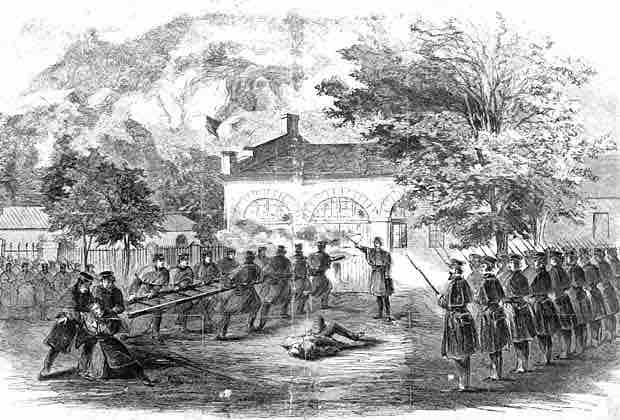John Brown, a radical abolitionist, instigated an armed slave revolt by seizing a U.S. arsenal at Harper's Ferry in Virginia in 1859. Brown's raid was quickly defeated by a detachment of U.S. Marines (led by Col. Robert E. Lee), but his actions convinced Southerners that their society was under attack by Northern abolitionists, inciting support for secession.
Brown, a failed business entrepreneur, had been raised in a deeply religious and antislavery family in Connecticut. However, Brown's vision of abolitionism was radically distinct from the more dominant antislavery sentiments in the North in that he believed that slavery was an unjustifiable state of war conducted by one group of people against another. Relying on stories in the Old Testament, Brown believed that violence against slavery and slave owners was a righteous, almost holy, act that would bring justice to black slaves and purify the wicked South. For Brown, the destruction of slavery required revolutionary force and violence as well as the shedding of blood.
Brown justified his beliefs using the biblical passage Hebrews 9:22: "Without shedding of blood there is no remission" of sin. Moments before he was hanged, Brown handed a prophetic note to a guard, which said, "I, John Brown, am now quite certain that the crimes of this guilty land will never be purged away but with Blood."
Brown had proven himself willing to use violence to attain his ends in the past: He had been involved in a murderous raid on some slavery supporters in Bleeding Kansas on Pottawatomie Creek in the Kansas Territory. Because of Brown's willingness to shed blood (including his own) for the cause, Frederick Douglass was later to comment that Brown's devotion to ending slavery was like a "burning sun" compared to his own candlelight. Douglass had prudently turned down Brown's invitation to take part in the raid.
By 1859, Brown had formulated a strategy for achieving his aim of defeating slavery through violence. He planned to use rifles, pikes, and other weapons that he seized at Harper's Ferry to arm Virginian slaves and lead them in an attack against slaveholders in the region, and from there, march South. However, although Brown and a small group of his supporters sacked the federal arsenal on October 16, 1859, a massive slave uprising did not occur, and a U.S. Marine force quickly captured Brown. He was taken to nearby Charles Town for trial where he was found guilty of treason against the commonwealth of Virginia and hanged on December 2. Six other raiders who joined the revolt were also executed.
Many Northern reactions to John Brown's raid are best characterized as baffled reproach. William Lloyd Garrison, a prominent leader of the antislavery movement, called Harper's raid a "misguided" and "insane" act. However, after Brown's execution (and the escalation of Southern hysteria over the incident), many Northerners came to believe that, although “insane,” Brown's attempts to liberate the slave population reflected moral intentions. Several prominent writers such as Ralph Waldo Emerson and Henry David Thoreau even praised Brown as a martyr for the abolitionist cause. For Southerners, on the other hand, John Brown's raid was an act of terrorism perpetrated by Northern abolitionists, an act that spurred Southern state legislatures to pass emergency measures to arm and train volunteer militias to prepare for future conflict with Northern aggressors.
The psychological significance of John Brown's raid on Harper's Ferry cannot be overestimated. Brown had hoped to lead armed slaves to insurrection. Slave revolts, especially armed ones, were especially terrifying for the South where some families lived on isolated farms and plantations and were outnumbered by their slaves. The South found the North's ambivalent attitude toward John Brown's raid flabbergasting. The raid and its repercussions led to deeper psychological rifts between the two regions of the country. A Southern newspaper, the Charleston Mercury, stated, "The day of compromise is past... There is no peace for the South in the Union."

Raid on Harper's Ferry
Harper's Weekly illustration of U.S. Marines attacking John Brown's "Fort."